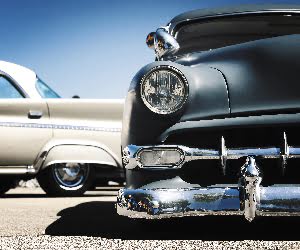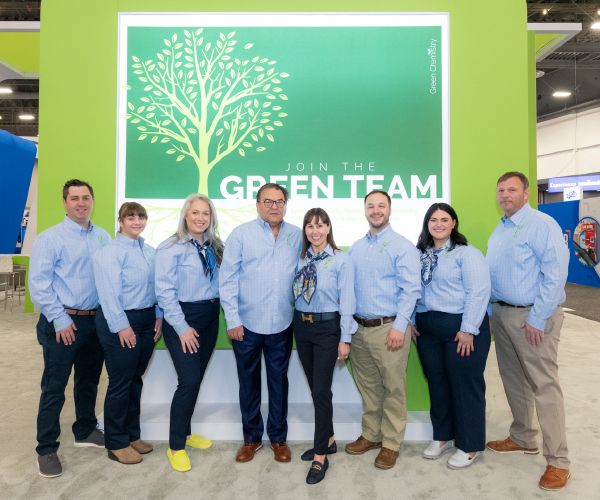
Blast from the Past - Spring 2014
January 2, 2014
6 minute ReadWe occasionally provide excerpts from The Great American Car Wash Story. Former ICA Executive Director Gus Trantham and veteran commercial writer John Beck wrote this book in 1994. It represents the most complete history we have found of the industry in North America. Enjoy.
Chapter 15
The Blower is a Manpower Saver in the Drying Area
One visible aspect of manpower in a full service car wash — which included practically all of them in the beginning — is the exit area where the final drying takes place. Here you can always see one or two cars being given the final drying touches by teams of attendants wielding towels in each hand. Some of these attendants who take their work seriously take a certain pleasure in their skill of turning out immaculate cars, and they will hum or whistle as they gyrate around outside — and inside the car to wash the interior glass — like ballet dancers working to their own private rhythms. To watch one make a final swipe with a towel at a vagrant drop, then open the door for you with a roguish grin and say, “Have a good day!” is to enjoy the pleasure of getting your car washed like new as you relax behind the wheel and roll out into the traffic in a car that sounds quieter, as well as more beautiful after having been washed.
On a busy day, these drying areas can be hectic pads of activity as towels are snapped around fiercely by extra attendants trying to cope with the cars emerging relentlessly from the final blower. These are the days when the towel washer/dryer is most likely to break down and new towels get broken out of storage as the wet ones pile up.
Yes, car wash manpower was particularly visible at those old exits, but it would have been much worse if it hadn’t been for the blowers that straddled the exits from which the cars emerged off of the conveyors. This would have added at least a couple more driers on normal days and maybe six or eight on volume days.
Actually, the first practical blower was the one that came with the Minit-Man system. This was an octopus type of an affair with eight hollow legs straddling the car where it rolled underneath with a couple of cloth bags that followed the roof of the car, all powered by a big centrifugal blower, and all under the control of that operator who had to keep his eyes on brushes, wheel washers and enough other items to make a man either nervous — or careless — after an hour or so.
Several other manufacturers then came out with their own version of blowers, most of them not too efficient. In 1950, Justee came out with a blower that had its equipment set in pits, but these pits soon developed the annoying habit of filling up with water.
Then Sherm Larson was asked by several car wash operators whom he had satisfied with powerful, dependable vacuums whether or not he couldn’t design a better blower/drying system. Particularly, the “Wash-Mo-Bile” people were anxious to get into conveyorized systems, so they commissioned Sherman to design them such a system. As Sherman recollected:
“Blowers weren’t too much different from vacuums, so I decided to give it a try. When we were finished, these blower/dryer systems were so well-received that I began to find our manufacturing facilities becoming more and more active in making car wash equipment. This stimulated me to pursue the car wash business much more aggressively. “
These blowers, which some operators were starting to call dryers, were just about that, at least in terms of results. There was just no other way of inducing water to evaporate off a car in the already water-laden atmosphere of a car wash. Jack Flapan had already tried that, if you recall, with his three-story high baker ovens fueled by a 5-inch gas main, which might have been good for baking enamel but was an over-heated flop for drying cars. The blower worked better by just driving the water off with high-velocity air, and this required plenty of power and speed delivered to the impeller.
One of the first Sherman blowers was a multi-stage, high-velocity 90 horsepower unit that was installed at the Mosswood Auto Laundry in Oakland, Calif., by his father and himself. With air velocities of up to 265 miles per hour and a heat rise of 500 F, this performed handsomely, blowing off most of the water so as to make the final hand-toweling easier. But blowing water off of cars required more than just providing high velocity air. It meant getting the nozzles close enough to the car body surface to send the water scooting off in the few seconds — usually less than a minute — provided as the car rolled along under the influence of the conveyor. It also meant filtering this air so that the end result didn’t become the equivalent of a sand blast and the repainting of a car!
To cope with high-volume business, many of the larger car washes used two blower units in tandem as well as chamois drag curtains to remove as much water as possible before emerging from the exit into the drying and final detailing area. All of this was great, but as early as 1960 a problem started to appear that affected the ability to get zoning clearances for the location of new car washes.
News:
As Robin King put it in the June 1962 issue of the ACWA:
“In the past 10 years, the auto laundry has given way to the new, modern car wash. The hose and chamois have almost disappeared from the scene; in their place are loud, cacophonous machines that have been designed to lessen our workload by ten-fold. But the manufacturers have not been concerned with the fact that these very wonderful labor saving machines have introduced profoundly raucous noises to jangle our taut nerves, lessen our employees efficiency … and annoy our customers.”
So what’s a little noise, you might ask? Well, ask Robin who continued:
“Sound is measured by a decibel scale in dBs. A modern car wash with high-pressure blowers lacking soundproofing will measure from 100 dB up to 125 dB at a distance of 10 feet from the noisy machine. Between 125 and 140 dBs of noise causes a pain in the inner ear, and at 150 the inner ear is damaged sufficiently to cause permanent deafness.”
“It would be difficult to ascertain the effect on customers at car washes of the ugly, high-piercing noises so prevalent today, but there is no doubt that our irritating noises are detrimental to business. No doubt a number of the people who refuse to patronize minute washes do not even realize why they don’t like our business establishments, but if the truth were known, it’s likely because we give them a pain in the ear!”
More than just a pain, this noise could even be a hazard to a business.
Robin gave this example:
“One car wash in the San Fernando Valley, near one of the movie studios, was threatened with court action by the studio unless they brought their blower noise down.
In this case, the car wash was located a full half mile from the closest outdoor set where the studio made recordings, yet the blower noise was audible enough, even at this distance, to be picked up by the recording devices used by the studio.”
Not just to be a doomsayer, Robin offered many valuable suggestions to reduce this problem, such as the use of multi-stage impellers, better sound insulation, the use of sound-deadening enclosures, and the use of trees and shrubs to absorb and deflect much of the noise. This stimulated the car wash equipment manufacturers to take the problem seriously so that much progress was made to produce car washes acceptable as neighbors. At the same time, much was done to increase efficiency and reduce horsepower requirements so many operators were able to switch over to blowers that were half the horsepower previously required, with considerable savings in electricity as well as reduced noise levels. Plus, of course, reduced hand-detailing requirements to get dry cars.








